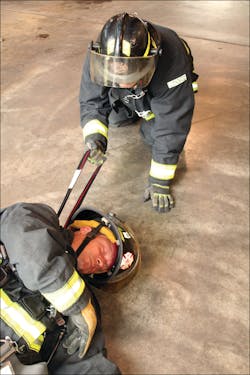Firefighter Rescue: The Drag Rescue Device
"Dispatch to all units -- time to prepare for your brush with death!"
Wow, would that statement get your attention? It definitely would grab mine. But, this statement may be just what we need to jumpstart our preparations before we are put in harms way. How prepared are you if something goes wrong while fighting a fire?
Welcome to the 2011 Fire/EMS Safety, Survival and Health Week. Let's take a look one piece of personal protection equipment that is always ready to help you in a Mayday. It's not the turnout coat, pants, boots, gloves, helmet or hood. Tucked away in newer PPE is the Drag Rescue Device (DRD), hoping that it's never deployed.
The DRD is a heavy-duty strap that's found in turnout coats that have been manufactured over the last few years. It provides a built-in upper torso harness, hidden inside the coat. A loop is tucked into the back of the jacket for rapid deloyment in downed firefighter situations.
It's our job to get comfortable with emergency devices, such as the DRD. This life-saving feature is required in all new turnout coats and provide an essential survival tool if you become an emergency. With that in mind, it also requires a level of familiarity in deploying and this is where training comes in.
Your DRD handle is typically designed for to be used with one hand to pull a downed or injured firefighter to safety. Simply pull the loop that's tucked into the back collar and you have an easy grip on the firefighter.
To help manuver the strickened firefighter you can place a tool, such as a Halligan, through the loop of the DRD so that two or more people can help with the firefighter removal. This can be done in wide hallways, rooms, etc. where's there's room for two or more members to operate.
Using a rope system with a mechanical advantage and attached to the handle of the DRD can aid in lessening the weight placed on the rescuer-firefighter, especially while bringing a downed firefighter up a stairway. This also makes it possible to use three rescuers where only two can fit.
These are few ideas of the use of the drag rescue device designed into newer PPE. We all need to take a moment during this year's Fire/EMS Safety Week to reacquaint ourselves with the most used safety device on the fireground, your PPE. We have seen many improvements in the past few years and we owe it to our families to be trained in proper use; just incase the unthinkable happens to us.
Have a great week focusing on safety everyone.
- Full coverage of the 2011 Fire/EMS Safety, Survival and Health Week
RYAN PENNINGTON, a Firehouse.com Contributing Editor, is a firefighter/paramedic for the Charleston, WV, Fire Department. He is currently assigned to Station 8 and a member of the West Virginia Task Force 1 USAR team. He has over 17 years of combined fire, rescue and EMS experience. Ryan is currently a West Virginia State Instructor 2, Hazmat Technician, and Certified Fire Officer 2. Ryan has been guest on several Firehouse.com podcasts including:Training & Tactics Talk: Searching in the Modern Environment and Engine Company Operations in Today's Buildings. View all of Ryan's articles and podcasts here. You can reach Ryan by e-mail at: [email protected].
